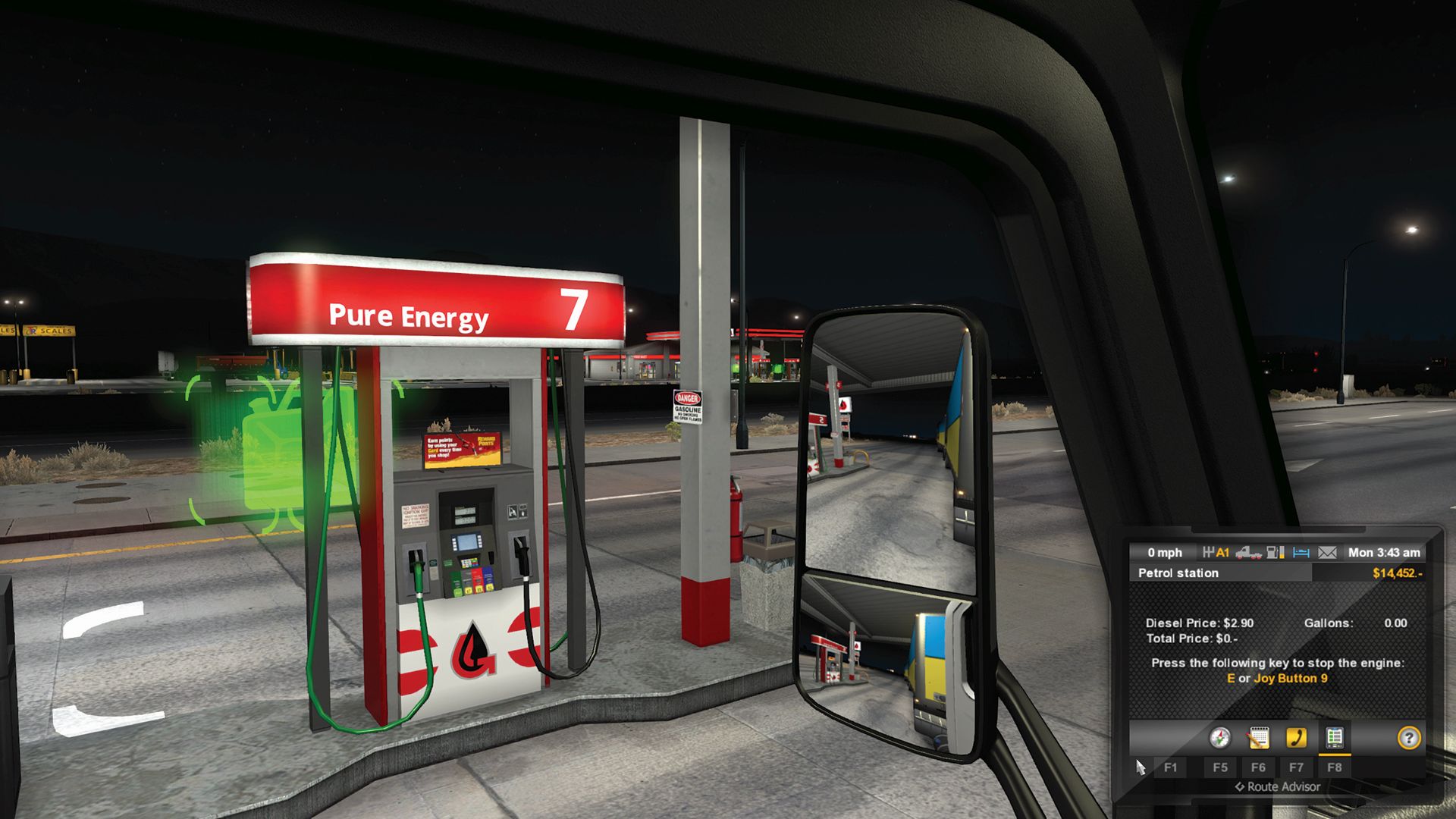Why I love driving at night in American Truck Simulator
Chilling out with one of the most relaxing games ever made.


In Why I Love, PC Gamer writers pick an aspect of PC gaming that they love and write about why it's brilliant. Today, Phil admires the peace of the open road.
I’m on the highway between Phoenix and Santa Fe, with 18 tonnes of furniture hitched to the back of my truck. This is not an exciting journey. In Holbrook I miss a turning—not ideal when a double trailer full of end tables makes reversing nigh impossible. I consider a manoeuvre, but my GPS updates with a new route. Sorted.
I’m deep into Gallup before I notice that I’m driving 20mph over the speed limit, but there are no patrol cars around so it isn’t a problem. I’m running out of fuel as I near Albuquerque. I open the map and reroute the GPS to the nearest petrol station. Problem solved. On the radio, blue-collar men sing about the ways in which, metaphorically speaking, their lives resemble that of dogs. This is not a story of close calls or heroics.
You could argue that American Truck Simulator is a boring game. You wouldn’t be wrong, but you would be missing the point. It is rarely eventful, at least outside of the unforced errors caused by a corner made at too high speed, a car clipped during a sloppy overtake or a trailer jackknifed as you turn too late at a tight intersection. But the tedium of long, uninterrupted stretches of road becomes almost entrancing—a distinct, soothing atmosphere that marks ATS as one of the most relaxing games around.

Crucially, ATS’s pace isn’t in service of a wider goal. Turn-based strategies, for instance, often feel slow and stately—the kind of games to be played over a Sunday afternoon with a pipe, slippers and a novelty stout. But the glacial rhythm of play is counterbalanced by stakes and peril. At various points throughout a campaign you’re required to think your way out of impending disaster. Even leisurely story-led adventures, like Firewatch and Gone Home, while tranquil in their moment-to-moment interactions, are pushing you forwards into escalating drama.
American Truck Simulator asks nothing but that a shipment of cheese makes it to Winnemucca. You’re given a route, but your mind is free to wander. You can revel in the landscapes, in the in-game radio, or the improbability of a world in which ancient, crushed zooplankton is poured into giant machines designed to haul dairy over a large distance.
You can have peril if you want it, but I find it ruins the experience. Euro Truck Simulator 2 became less enjoyable the moment I took on employees. Suddenly, I was handed the pressures of a small business owner, studying the performance of my inexperienced hires, and worrying about getting office supplies to Dortmund in time to make a loan repayment. When I started ATS, I decided it was all about me—no business, no pressure, just the evocative vistas of rural America.
There are currently four states in American Truck Simulator and they all beautifully convey the sheer size of the country. As in Euro Truck Simulator 2, the landmass is truncated, but it doesn’t matter. We’re conditioned by open world games to shift our perception of scale, often through time manipulation. American Truck Simulator’s day-night cycle feels longer than most—long enough for an overnight drive to feel like a serious undertaking. You get an inherent understanding of how far you’ve travelled when you hitch a trailer in the evening and arrive as the sun is rising.
Keep up to date with the most important stories and the best deals, as picked by the PC Gamer team.

I prefer driving at night because it enhances the atmosphere—turning something familiar and workmanlike into something lonely and romantic. Daytime deliveries are a job. I sit in traffi c, surrounded by NPCs, waiting to get to somewhere. At night, all you see are the passing lights of sporadic cars—isolated islands of activity in a vast, barren nothingness. A small town takes on added signifi cance when its lights pierce the dark.
American Truck Simulator is remarkable because it offers just the right amount of interaction to keep you present but not overwhelmed. Though it may have been designed to fulfi l the needs of an audience obsessed with realism, it doubles as meditative self-care for people who need to quiet the growing noise of life in 2018. There are no stresses on the road to Fresno. Just 20 tonnes of accessories, a rumbling engine, and a country music singer explaining why he’s back in the doghouse, oh yeah.

Phil has been writing for PC Gamer for nearly a decade, starting out as a freelance writer covering everything from free games to MMOs. He eventually joined full-time as a news writer, before moving to the magazine to review immersive sims, RPGs and Hitman games. Now he leads PC Gamer's UK team, but still sometimes finds the time to write about his ongoing obsessions with Destiny 2, GTA Online and Apex Legends. When he's not levelling up battle passes, he's checking out the latest tactics game or dipping back into Guild Wars 2. He's largely responsible for the whole Tub Geralt thing, but still isn't sorry.

